Guitar
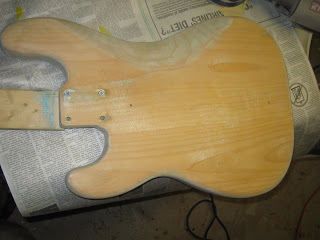
Another fine vintage Fender bass has come my way - and the owner, inspired by my Fiesta Red refin of a 1964 P-bass, asked if I could do the same for his 1963, clay dot example, which had been refinished some years ago in a light metallic teal color, with a matching headstock.
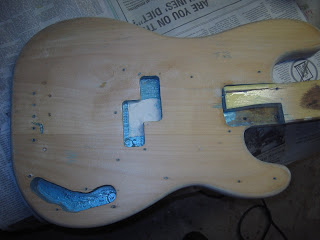
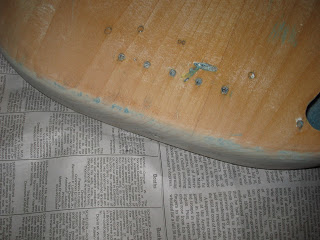
Dyed yellow and sealed with a light coat of vinyl sealer. This still left some grain visible, so recoated with nitro cellulose to seal the wood fully. Also plugged extra strap button holes - had a lot over the years!
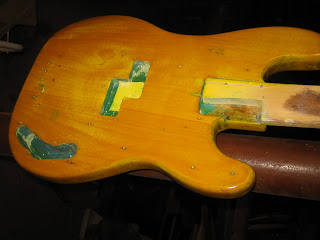
priming - wet sanded in effort to keep overall finish as thin as possible
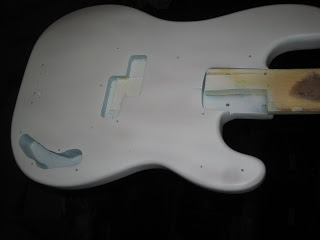
Filling in flaws - mostly on edges and few areas that had scratched from prior refins - top. After a touch up with some primer and a light wet sanding, it was ready for color coat.
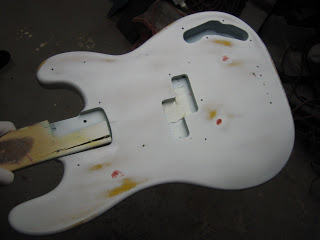
The color went on smoothly - with just a few little flaws.
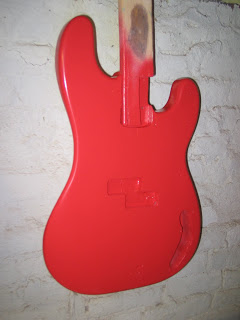
After another wet sanding of the areas that I thought needed some touch up - I sprayed one more thin coat of Fiesta Red on the front only of the body, followed by a clear coat of nitro once it had dried for a day. After allowing the body to dry for about a week and a half, I wet sanded it with 800 grit, working my way down to 1500 grit, before doing my usual three step buffing and polishing process. I believe I removed most of the clear coat in the process - which was in line with the owner's desire for a very thin finish.
But as you can see, it still came out looking like a shiny new 1956 Thunderbird ...
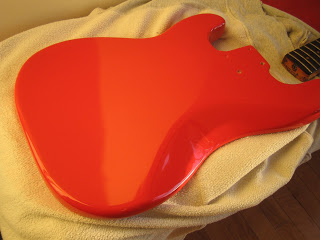
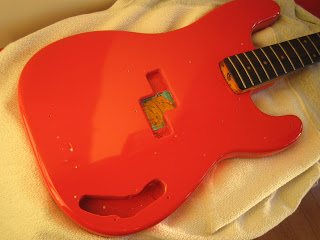
Headstock
This bass had unfortunately been modified sometime in the past for non-stock tuners - and the headstock had actually been redrilled for four different tuners! Please don't do dumb-ass things like this to your poor old guitars and basses !!!
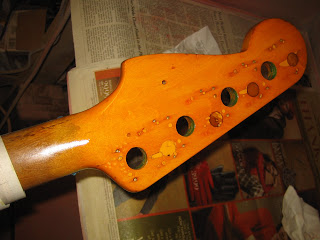
The current owner had the new holes plugged and a maple veneer applied to the front of the headstock. Given the work that had been done, he then had the headstock refinished in a metallic teal green to match the body. With the refin of the body underway, he decided to strip the headstock and see how the veneer underneath looked - and hopefully be able to have me refinish it in an aged clear coat.
The veneer actually looked very very good once it was stripped - here it is with a new decal roughly positioned. Notice that the line between the veneer and rosewood fretboard is a little uneven - this was also cleaned up later through careful use of an Xacto knife and some masking tape.
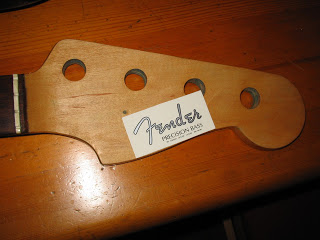
I decided to get a little elaborate on the headstock refin - if you have seen Fender instruments from the 60s with heavily yellowed headstock, you'll notice that the finish under the decal film doesn't yellow as much as the rest of the headstock - making the decal film pretty prominent. This can be really pronounced on custom color headstocks - Olympic White thats yellowed especially.
I decided I'd try to get a similar look with this headstock by cutting a mask to the same shape as the typical Fender headstock logo shape - and not ambering the finish under the decal as much as the rest of the headstock. I cut the decal and an added piece of paper to a typical 60s shape - then used the paper as a mask on the headstock once I had applied a base level of ambered clear coat.
 \
\
Then I added several more coats to bring the whole headstock to the final color I wanted.
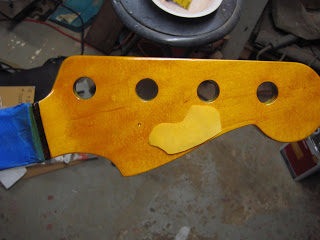
When the finish had dried, peeling away the mask revealed a lighter area on the headstock.
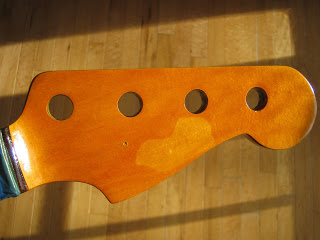
I then applied the water slide decal in the typical fashion - soaking it in plain water and applying some decal setting solution (basically white vinegar) to the headstock - and then sliding the decal on - aligning it with the lighter area.
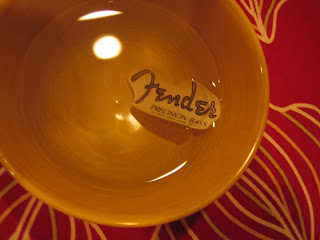

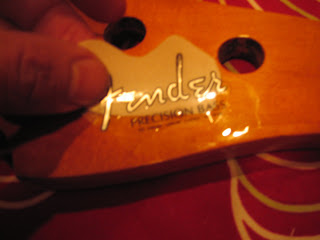
Once the decal was positioned and any extra setting solution was swabbed off, I applied a little decal softening solution to really set the decal into place. Once it was dry, I had a very convincing looking headstock - now if I can just learn how to do finish checking ...
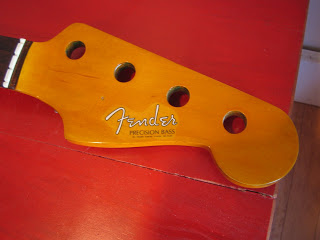
A final picture of the neck and body together - eventually the owner will send me some pictures of the complete bass once he reassembles it.
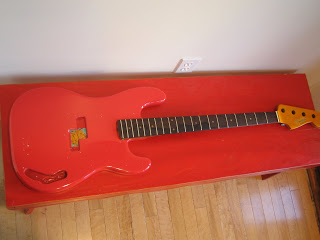
(Update Jan 23, 2009)
Steve sent me a few snapshots of the bass completely assembled - still very shiny at this stage, but I'm sure he'll break it in over time!!
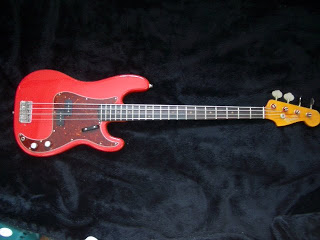

- 1965 Fender Jazzmaster, Candy Apple Red Restoration
My buddy Rod brought this guitar to me a few years ago - he had purchased it because it was almost entirely original - with the exception of the factory Candy Apple Red finish, which was stripped off. The original finish remained in the pickup...
- 1968 Fender Jazz Bass: Sonic Blue Regret And Restoration
This project represents an unfortunately common scenario from the 1970s, where an instrument's owner decided that the "natural" look was preferable to the original factory custom color. Guess the attitude was that "wood was good" - during this...
- Surf Green 60s Style Makeover: Fender Precision Lyte
This was a fun project to take a fairly recent and "modern" Fender bass and modify it to give it more of a 1960s vibe. The bass was a 1994 Japanese made Fender Precision Lyte, with a red photoflame sunburst finish on a super lightweight basswood body....
- 1966 Fender Jazzmaster: Aged Olympic White
< A fairly straightforward project here - a 1966 Fender Jazzmaster body that had been poorly refinished over the years and that the owner wanted to do in an aged Olympic White finish. The original Olympic White is a color thats seldom seen - its a bright...
- 1964 Fender Precision Bass Refinish To Fiesta Red
A customer just dropped off his bass for me to work on - a very very nice 1964 Precision Bass - that had been stripped and refinished in clear sometime during the intervening 4 decades. He has requested that I refinish the bass in a classic 1960s Fender...
Guitar
1963 Fiesta Red Fender Precision refinish ala Bruce Thomas
Another fine vintage Fender bass has come my way - and the owner, inspired by my Fiesta Red refin of a 1964 P-bass, asked if I could do the same for his 1963, clay dot example, which had been refinished some years ago in a light metallic teal color, with a matching headstock.
Dyed yellow and sealed with a light coat of vinyl sealer. This still left some grain visible, so recoated with nitro cellulose to seal the wood fully. Also plugged extra strap button holes - had a lot over the years!
priming - wet sanded in effort to keep overall finish as thin as possible
Filling in flaws - mostly on edges and few areas that had scratched from prior refins - top. After a touch up with some primer and a light wet sanding, it was ready for color coat.
The color went on smoothly - with just a few little flaws.
After another wet sanding of the areas that I thought needed some touch up - I sprayed one more thin coat of Fiesta Red on the front only of the body, followed by a clear coat of nitro once it had dried for a day. After allowing the body to dry for about a week and a half, I wet sanded it with 800 grit, working my way down to 1500 grit, before doing my usual three step buffing and polishing process. I believe I removed most of the clear coat in the process - which was in line with the owner's desire for a very thin finish.
But as you can see, it still came out looking like a shiny new 1956 Thunderbird ...
Headstock
This bass had unfortunately been modified sometime in the past for non-stock tuners - and the headstock had actually been redrilled for four different tuners! Please don't do dumb-ass things like this to your poor old guitars and basses !!!
The current owner had the new holes plugged and a maple veneer applied to the front of the headstock. Given the work that had been done, he then had the headstock refinished in a metallic teal green to match the body. With the refin of the body underway, he decided to strip the headstock and see how the veneer underneath looked - and hopefully be able to have me refinish it in an aged clear coat.
The veneer actually looked very very good once it was stripped - here it is with a new decal roughly positioned. Notice that the line between the veneer and rosewood fretboard is a little uneven - this was also cleaned up later through careful use of an Xacto knife and some masking tape.
I decided to get a little elaborate on the headstock refin - if you have seen Fender instruments from the 60s with heavily yellowed headstock, you'll notice that the finish under the decal film doesn't yellow as much as the rest of the headstock - making the decal film pretty prominent. This can be really pronounced on custom color headstocks - Olympic White thats yellowed especially.
I decided I'd try to get a similar look with this headstock by cutting a mask to the same shape as the typical Fender headstock logo shape - and not ambering the finish under the decal as much as the rest of the headstock. I cut the decal and an added piece of paper to a typical 60s shape - then used the paper as a mask on the headstock once I had applied a base level of ambered clear coat.
Then I added several more coats to bring the whole headstock to the final color I wanted.
When the finish had dried, peeling away the mask revealed a lighter area on the headstock.
I then applied the water slide decal in the typical fashion - soaking it in plain water and applying some decal setting solution (basically white vinegar) to the headstock - and then sliding the decal on - aligning it with the lighter area.
Once the decal was positioned and any extra setting solution was swabbed off, I applied a little decal softening solution to really set the decal into place. Once it was dry, I had a very convincing looking headstock - now if I can just learn how to do finish checking ...
A final picture of the neck and body together - eventually the owner will send me some pictures of the complete bass once he reassembles it.
(Update Jan 23, 2009)
Steve sent me a few snapshots of the bass completely assembled - still very shiny at this stage, but I'm sure he'll break it in over time!!
- 1965 Fender Jazzmaster, Candy Apple Red Restoration
My buddy Rod brought this guitar to me a few years ago - he had purchased it because it was almost entirely original - with the exception of the factory Candy Apple Red finish, which was stripped off. The original finish remained in the pickup...
- 1968 Fender Jazz Bass: Sonic Blue Regret And Restoration
This project represents an unfortunately common scenario from the 1970s, where an instrument's owner decided that the "natural" look was preferable to the original factory custom color. Guess the attitude was that "wood was good" - during this...
- Surf Green 60s Style Makeover: Fender Precision Lyte
This was a fun project to take a fairly recent and "modern" Fender bass and modify it to give it more of a 1960s vibe. The bass was a 1994 Japanese made Fender Precision Lyte, with a red photoflame sunburst finish on a super lightweight basswood body....
- 1966 Fender Jazzmaster: Aged Olympic White
< A fairly straightforward project here - a 1966 Fender Jazzmaster body that had been poorly refinished over the years and that the owner wanted to do in an aged Olympic White finish. The original Olympic White is a color thats seldom seen - its a bright...
- 1964 Fender Precision Bass Refinish To Fiesta Red
A customer just dropped off his bass for me to work on - a very very nice 1964 Precision Bass - that had been stripped and refinished in clear sometime during the intervening 4 decades. He has requested that I refinish the bass in a classic 1960s Fender...
